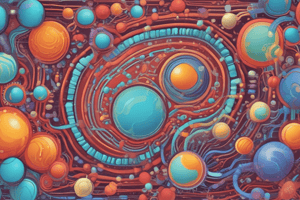Podcast
Questions and Answers
¿Cuál es el papel principal de las cascadas de MAPK en la transmisión de señales?
¿Cuál es el papel principal de las cascadas de MAPK en la transmisión de señales?
- Inhibir la diferenciación celular
- Regular el estrés celular
- Promover la apoptosis
- Controlar la división celular (correct)
¿Cuál es la función específica de ERK en la vía de señalización ERK/MAPK?
¿Cuál es la función específica de ERK en la vía de señalización ERK/MAPK?
- Regular el metabolismo celular
- Transmitir señales extracelulares a objetivos intracelulares (correct)
- Inhibir la comunicación celular
- Activar proteínas reguladoras
¿Cuál es una característica esencial del camino de señalización JNK en las cascadas de MAPK?
¿Cuál es una característica esencial del camino de señalización JNK en las cascadas de MAPK?
- Transmisión de señales a través del metabolismo
- Inhibición de respuestas al estrés
- Regulación del crecimiento celular
- Participación en la diferenciación celular (correct)
¿Cuál es la función principal de las fosforilaciones en cascada en la activación de MAPK?
¿Cuál es la función principal de las fosforilaciones en cascada en la activación de MAPK?
¿Qué papel desempeñan las proteínas MAPKAPK en las cascadas de MAPK?
¿Qué papel desempeñan las proteínas MAPKAPK en las cascadas de MAPK?
¿Cuál de las siguientes afirmaciones es correcta con respecto a la activación de MAPK?
¿Cuál de las siguientes afirmaciones es correcta con respecto a la activación de MAPK?
¿Cuál de las siguientes opciones NO es un mecanismo de activación de las cascadas de MAPK?
¿Cuál de las siguientes opciones NO es un mecanismo de activación de las cascadas de MAPK?
¿Cuál de las siguientes afirmaciones es FALSA con respecto a los mecanismos de control de las cascadas de MAPK?
¿Cuál de las siguientes afirmaciones es FALSA con respecto a los mecanismos de control de las cascadas de MAPK?
¿Cuál de las siguientes afirmaciones es VERDADERA con respecto al papel de las cascadas de MAPK y la fosforilación?
¿Cuál de las siguientes afirmaciones es VERDADERA con respecto al papel de las cascadas de MAPK y la fosforilación?
¿Cuál de las siguientes opciones NO es un componente involucrado en la activación de la vía Raf-MEK-ERK?
¿Cuál de las siguientes opciones NO es un componente involucrado en la activación de la vía Raf-MEK-ERK?
Study Notes
Phosphorylation Cascades and MAPK Activation
Mitogen-activated protein kinase (MAPK) cascades play a crucial role in transmitting signals from extracellular stimuli to intracellular targets. These cascades consist of a series of protein kinases that work together to regulate various cellular processes such as cell growth, development, division, stress responses, and apoptosis. The ERK/MAPK signalling pathway, specifically, is considered the most thoroughly studied MAPK cascade and is central to regulating cell proliferation and differentiation.
ERK/MAPK Signalling Pathway
Extracellular signal-regulated kinase (ERK) belongs to the MAPK family and is involved in signalling cascades that transmit extracellular signals to intracellular targets. These cascades involve three to five layers of protein kinases called MAPK kinase kinase (MAP3K), MAPK kinase (MAPKK), MAPK, and MAPK-activated protein kinases (MAPKAPK). The first three central layers are considered the basic core unit, while the last two layers vary among cells and stimuli. Four MAPK cascades have been defined based on their components: ERK1/2, c-Jun N-terminal kinase (JNK), p38 MAPK, and ERK5.
Phosphorylation Cascade
Phosphorylation cascades involve the sequential activation of multiple layers of protein kinases. These cascades transmit signals through direct phosphorylation of tyrosine (Tyr) and threonine (Thr) residues by conventional MAPKs, followed by activation of a family of protein kinases known as MAPK-activated protein kinases (MAPKAPKs). The MAPKAPKs act as an amplification step in the MAPK catalytic cascades and regulate a wide range of biological functions.
MAPK Activation Mechanisms
Activation of MAPK occurs through a process involving several steps. In the case of the Raf-MEK-ERK pathway, the essential linkers from epidermal growth factor receptors (RTKs) to MAP kinase include adaptor proteins like Grb2 and guanine nucleotide exchange proteins such as Sos, which lead to activation of small GTP binding proteins like p21ras and eventually activate MAPK kinase kinase (MAPKKK) and MAPK kinase (MAPKK), ultimately leading to phosphorylation and activation of MAPK. Other mechanisms involve the activation of JAK tyrosine kinases by cytoplasmic proteins such as Shc, which can then activate the ERK1/2 pathway through phosphorylation of specific substrates. Additionally, G protein-coupled receptors (GPCRs) can stimulate activation of MAPK cascades through tyrosine phosphorylation of RTKs like the EGF receptor.
Control Mechanisms
MAPK cascades are highly regulated processes that involve a variety of regulatory factors. These include scaffold proteins and bispecific phosphatases that maintain MAPKK and MAPK levels within a narrow range, ensuring proper signal transmission. The structural organization of MAPK components also plays a role in controlling the activity of these cascades, with MAPK and MAPKAPK components serving to phosphorylate a wide range of substrates that ultimately regulate most stimulated cellular processes.
In conclusion, phosphorylation cascades and MAPK activation play essential roles in transmitting signals from extracellular stimuli to intracellular targets, allowing cells to respond appropriately to their environments and maintain normal cellular functions. Understanding these mechanisms is crucial for understanding various physiological processes in cells, including growth, development, division, and death.
Studying That Suits You
Use AI to generate personalized quizzes and flashcards to suit your learning preferences.
Description
Aprende sobre las cascadas de fosforilación y la activación de las quinasas activadas por proteínas mitógenas (MAPK), importantes en la transmisión de señales desde estímulos extracelulares hacia blancos intracelulares. Descubre cómo estas cascadas regulan procesos celulares como el crecimiento, desarrollo, división, respuestas al estrés y apoptosis.




